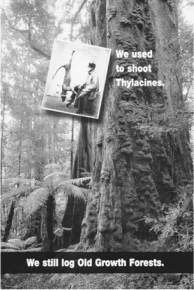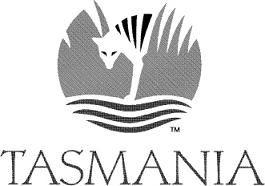Thylacine (23 page)

It means that if the Tasmanian tiger emerges out of the Tarkine, along the pipeline track, for instance, and it is then decided you need 10 000 hectares to protect it and any other animals in there with it, then the Commonwealth [government], if it does that, is obliged to compensate [the forestry company] for the loss of that resourceâall those trees. It would cost tens, if not hundreds of millions of dollars.
3
Conservation issues remain highly emotive in Tasmania because there is seen to be a close correlation between one form of environmental extinction and another. For many Tasmanians, old growth logging has been so comprehensive for so long that it differs little from the thylacine slaughter in which their forebears indulged. Thus it was that in the lead-up to the 2002 state election a pressure group, the Tasmanian Community Alliance, was formed to put the extinction issue firmly on the agenda. The Alliance's television advertising campaign was spearheaded by the famous/infamous âMr Weaver bags a tiger, 1869' photograph, with the advertisement drawing âa parallel between old growth logging now and Tasmanian government policy 100 years ago which allowed Tasmanian tigers to be shot until they were extinct'.
4
The advertisement went to air regularly in prime time. Geoff Law, longtime campaign coordinator of the Wilderness Society, was unequivocal about the reason for its success and what might flow from that:

A pressure group, the Tasmanian
Community Alliance, used this
pamphlet during a state election to
gather support for its stand on
protecting old growth forests. The
insert photoââMr Weaver Bags a
Tiger'âis famous for being infamous
as a symbol of the wanton persecution
of the animal.
(Tasmanian Community Alliance, Hobart)
The Thylacine is a potent symbol of all the mistakes of the past, especially in the imagery of a dead thylacine upside down in the Weaver photo. There's a sense of tragedy, vulnerability, the immense regret that people experience. If only we knew then what we know now, that wouldn't have happened, and yet we admit cheerfully to turning these magnificent, statuesque forests into woodchips for export . . . If there's an end to old growth logging then we'll have a proper World Heritage area with the most appropriate boundaries for it, instead of a hacked-up ragged edge that we've got now, with chunks left out for loggers and miners. In terms of an all-pervasive, oppressive issue, the forestry one will hopefully be the last one to be dealt with . . . They don't need to keep invading valleys that have never seen an axe.
5
The thylacine had only once before been used to so directly attempt to influence Tasmania's political landscape. Its last appearance as a political animal had been in the 1887 debates which put the statewide bounty in place. More than a century later, it continues to vex Tasmanians:
It's funny how there's this fascination with the creature, partly because it's a large predator, partly because of the mystery as to whether it's there or not. And it even becomes a joke, almost. âThe Thylacine: maybe we'll see one' . . . It becomes light-hearted, which completely glosses over the tragedy that occurred. The thought that it might still be there actually allows people to overlook the horrific crimes of the past in ensuring its extermination. A quite deliberate, systematic extermination of the thylacine occurred, but people don't want to face up to itâthat that's what Tasmanians did.
6
I was driving home to Railton . . . in a trap pulled by a fine white pony called Robin. As we neared Railton he suddenly stopped dead in the road so that we were nearly thrown out. He refused to budge and then we saw the reason, a Tasmanian Tiger had come out of the bush to cross the road and both tiger and pony met in the middle and eyed one another . . . The tiger slowly crossed to the other side and disappeared into the thick bush. It was dusk but we had a good side view so that its stripes were distinctly visible. It was several minutes before the pony would move on.
E
LMA
K
IDD,
W
EST
L
AUNCESTON
T
he longer the thylacine stays dead, the greater the interest it arouses. That is quite an achievement for an officially extinct species which in its lifetime was not seen to have the fearful charm of the exotic jungle cats, Africa's big five, grizzly bears and the like. Yet it has been kept alive by considerably more than regret. As symbol, art object and metaphor, the thylacine holds lofty status, being accorded a degree of patriotic regard (like the bald eagle), a degree of reverence (like the cat in ancient societies), achieving something of the symbolism of the unicorn in literature and heraldry, and becoming a sporting icon (in company with wallabies, kangaroos, devils, springboks, lions, cougars, hawks, magpies, dolphins, sharks et al.).
The thylacine has about it a sufficiently powerful and ambiguous mystique that it is able to comfortably represent and embrace much that is Tasmanian. Thus, in a display of unintentional dark humour, a pair of heraldic thylacines stand rampant in the state's Coat of Arms, supporting and protecting a ram in the centre of the shield. It may also be seen on Tasmanian car licence plates and is the fetching logo of the City of Launceston. A television station, a furniture removal company, a fruit and vegetable wholesaler, an abalone company, a bus line, a supermarket, a publisher, craft stalls at Hobart's famous Salamanca

The Tourism Tasmania logo has abstracted the thylacine to a high degree that is, in
fact, appropriate, given that the real thing has not been seen for at least 70 years. As a brand symbol it's an undoubted success, attracting large numbers of tourists to
Tasmania to enjoy the island's âwilderness' experience.
(Tourism Tasmania)
Market, retailers of tourist kitsch, and many others, merrily trade under and off the tiger identity.
Tourism Tasmania, operating within a government department, makes saturation use of the image to lure visitors to âYour Natural State'. The logo's designer, Ian Kidd, explains the philosophy behind it, reading in part:
The Department, having commissioned intensive research and design activity, [now] had a visual identity with which to identify and market Tasmania to target audiences locally, interstate and overseas . . . Whether still alive or extinct, the Tasmanian tiger is unique and immediately identified with the State to the extent that it has become mythicised. As an animal it isn't just a symbol of Tasmania; as has been depicted in the logo, it is a symbol of the Tasmanian Experience . . . The symbol graphically depicts a Tasmanian tiger in a wilderness environment. The form comprises three elements; being the tiger, vegetation and water composed within an imaginary circle.
1
In the non-government sphere, Hobart's Cascade Brewery Company reigns supreme in commercial usage of the thylacine. The gracious sandstone building and storage tanks of Australia's oldest brewery, established in 1834, occupy an unrivalled site at the base of Mount Wellington. That striking image long carried much of the company's advertising fortunes, but a point was reached in the 1980s when the company needed a different kind of help. Enter the thylacine.
A growing demand for premium brews, nationally and internationally, obliged Cascade to test that market, in the face of stiff competition from the big established players like Heineken, Budweiser, CUB's Crown Lager and Carlsberg. Cascade's new product, released in 1987, was a considerable success, not least through the use of the mountain's pure water, locally grown and malted barley and a long maturation period of six weeks. But in the crucial marketing area lay its real secret ingredient: tapping into Tasmania's new image as environmentally clean and progressive, a complete contrast to the jaded metropolitan world of the target market, well-heeled beer drinkers.
Designer Ken Cato created a label closely based on H. C. Richter's 1850s lithograph for John Gould. (Gould had written: âThe circumstance of a fine pair, male and female, of the
Thylacinus cynocephalus
being now living in the Gardens of the Zoological Society in the Regent's Park, enables me to give the best figure of the animal that has yet appeared . . .'.
2
)
In combination with an unusual light green glass and expensive packaging (the latter to protect the beer from hop-spoiling ultra-violet light, which doesn't penetrate brown glass), the visual strength and somewhat mysterious allure of the label helped make the new premium line instantly successful. The following year Cato won an award from the New York Art Directors Club. Today, Cascade's Premium Lager and Premium Light are bestsellers throughout the developed world.
In all likelihood Cato's design was inspired by the fact that the brewery had had a prior relationship with the thylacine. In the 1870s artist William Piguenit used one in an advertisement he designed for the company; also at that time, stonemason Edward Martin Richards sculpted a thylacine atop a beer barrel for the company's city office. It's a well-known Hobart featureâ for those who know to look up at 156 Collins Street.
Even here there are controversies, though one is mild and amusing. For some reason Cato, in adapting the Richter lithograph, extended the stripes to the tips of the tails. It is a sufficiently odd alteration to make one want to go and buy a sample of the product, if only to gaze at those most un-thylacine-like appendages.
At a different level of controversy altogether, an Aboriginal legal bid is currently in place to claim copyright over native animal imagesâparticularly the thylacine, emu, platypus and kangarooâas sacred symbols. According to Tasmania's Aboriginal and Torres Strait Islander Commissioner, Rodney Dillon, in an article in
The Mercury
on 31 January 2002, âThese native animals are part of our people and it is an insult the way they are being used . . . They steal our land and they steal our animals and then they use them as their signs. Cascade should use a fox on its labels instead. That's what they [whites] brought with them'.
3
A follow-up report the next day stated that âone senior Cascade source' conceded that the Aborigines had a point and that the company recognised the sensitivity of the issue.
Cricket is Australia's national summer game and the thylacine features prominently as the identifier of Tasmanian cricket. The logo of the Tasmanian Cricket Association (TCA) cleverly integrates the animal with the game by having its stripes represent the wicket and the seam of a ball. The state one-day teamâsuitably sponsoredâis presently known as the Cascade Tasmanian Tigers, with a heavily stylised tiger face projecting the right degree of sporting alertness and aggression.
The TCA's Media and Public Relations Manager, David Boon (himself a Tasmanian icon, with a test cricket career aggregate of 7422 runs in 107 Test matches at a splendid average of 43.65), explains the 1995 adoption of the name Tasmanian Tigers:
Its purpose was to identify and brand the Cascade Tasmanian Tigers cricket team as distinct from the corporate logo of the Tasmanian Cricket Association. Informal but extensive research showed overwhelming public support for the Tiger image. The research had involved seeking the opinions on a range of names from high school studentsâa key market sector for merchandisingâplayers and the general public. Ten names were offered.
The Tigers was a clear winner with thirty-six per cent of the vote . . . The Tasmanian tiger was used because of its uniqueness. No other state can claim it. It is/was a sleek, cunning and aggressive carnivoreâ a killer. If it still exists, it is elusive, surrounded by mystery and extremely hard to track down. It certainly projects an appropriate image for our cricket team. The logo is associated with all that is the Tasmanian Cricket Team and it is used on all advertising, uniforms and merchandising relating to that team.
4